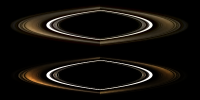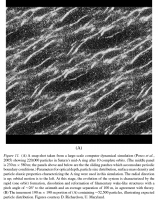Printable Version of Topic
Click here to view this topic in its original format
Unmanned Spaceflight.com _ Saturn _ Mass of Saturn's rings
Posted by: alan Oct 7 2007, 04:39 AM
A quote from a DPS abstract Emily linked to in here latest blog
The inferred total mass of Saturnís ring is therefore likely to be at least three times more massive than previously estimated, or three times more massive than the satellite, Mimas. ![]()
Wow, I had no idea they were that massive.
Posted by: dvanavery Oct 7 2007, 07:19 AM
Here's the http://www.abstractsonline.com/viewer/viewAbstract.asp?CKey={91F31285-7BCA-49DF-BA70-B1B1E5D5F2BF}&MKey={ADDC1E2E-9B5A-4D9F-B9E3-2D6700638A29}&AKey={AAF9AABA-B0FF-4235-8AEC-74F22FC76386}&SKey={5132F771-89E2-449B-9E1C-21EB74C5B457}
This is fascinating, assuming it holds up. Some pre-Cassini texts claimed, IIRC, that the entire ring system could be contained within a 150km diameter moonlet, actually quite a bit smaller in mass than Mimas. So this is a substantial increase indeed. I would think this has all sorts of implications for the dynamic evolution of the innermost satellite system (Mimas-Enceladus-Tethys and associated "rocks") subsequent to the formation of the ring system itself. 3 Mimas masses worth of dynamically fluid rubble could have caused (and is likely still causing) all sorts of subtle effects.
Of course, the http://www.abstractsonline.com/viewer/viewAbstract.asp?CKey={D78623F4-32EF-4E20-87D2-B70EF7E17168}&MKey={ADDC1E2E-9B5A-4D9F-B9E3-2D6700638A29}&AKey={AAF9AABA-B0FF-4235-8AEC-74F22FC76386}&SKey={5132F771-89E2-449B-9E1C-21EB74C5B457} comes with implications of its own....
It never fails to amaze me just how fantastically complex the gravitational interactions are within the Saturn system. And 3.5 years into the Cassini mission, we're still struggling to pin down such basic things as ring system mass!
(I favor the first abstract over the second)
-dave V.
Posted by: tasp Oct 8 2007, 02:08 AM
Just throwing out an idea I am unable to evaluate mathematically, and would not be too suprised if the actual computation wouldn't constipate a super computer:
Could the rings be equivalent to a 'spring'. In regards to 'absorbing' or 'storing' or 'releasing' resonant gravitational energy ??
We note many pairs of satellites at Saturn as being close to in resonance with each other (my favorite, Titan and Iapetus being close to 5:1) but other than Titan/ Hyperion, 4:3, we don't see any pairs actually in resonance.
Perhaps the satellites briefly do go into resonance sporadically, but then the appropriate 'sub' resonant region in the Saturnian ring system interacts with the resonant relationship and knocks it off.
For example, let's say Titan and Iapetus do 'pop' into the 5:1 resonance, then the ring system reacts to that, reacts with itself, and knocks Titan and Iapetus back off the resonance.
We might be looking at a system in a form of 'meta' resonance, where various pairs of moons 'lock up' briefly and the rings store/damp/transfer energy around the system. In this period, (other than Titan/Hyperion which might be a special permanent case due to the large mass ratio and adjacent orbits) we don't observe any moon pairs in 2:1, 1:3, 2:7 etc., but perhaps we see the effects in the Enceledosian geysers, Dionesian cliffs, etc.
How do we evaluate such a subtle gravitational effect in a mega multi n body problem ??
Posted by: ugordan Oct 8 2007, 10:01 AM
AFAIK, Enceladus and Dione are in a 2:1 http://en.wikipedia.org/wiki/Orbital_resonance#Mean_motion_resonances_in_the_Solar_System.
Posted by: ngunn Dec 7 2007, 10:43 AM
Somewhat OT but not worth a new thread -
I'm not a rings person but the stated ring thickness of about 20 metres in the latest Cassini-Huygens website's front page article took me by surprise. Last time I checked (about 20 years ago) they were supposed to be about a kilometre thick. Could somebody point me to the proper source, or convenient review thereof, for the new ultra-thin estimate?
Posted by: edstrick Dec 8 2007, 11:28 AM
" Last time I checked (about 20 years ago) they were supposed to be about a kilometre thick. "
The Voyager radio occultation showed UNRESOLVED sharp edges in ring structures at some 20 meters resolution in rather oblique viewing geometry, showing the rings to be at least that thin at those locations.
The "kilometer" thick estimate comes from edge-on views where the ring ansae parts <sticking beyond saturn> reach a minimum brightness when they'd be exactly edge on if they were flat. Tidally induced ring-warp, plus small particles tossed relatively far from the ring plane and "inflated" parts of the rings at edges and spiral warps at resonances all contribute to the rings apparent overall thickness when seen edge on.
Posted by: ngunn Dec 8 2007, 06:12 PM
Thanks for that very clear explanation, edstrick. I'm now readjusting my mental image of the place accordingly. My feet are in among the footballs and my head is in empty space. My buddy, only a few metres 'below' me is doing the same on the other side. I'm in the sun and he's in the shade. Extraordinary!
Posted by: edstrick Dec 9 2007, 10:22 AM
Ignoring complex dynamics that make the "wheat straw" patterns in the A ring and !!! hollow tubes !!! of narrow ringlets in the C ring (that analysis some 15+ years ago was based on the Voyager data) Part of what's going on his that the golf-cart to SUV sized ring-boulders basically orbit in the ring plane, quite probably not normally varying by one radius from the ring plane (or some such number). Smaller ring boulders... Basket Ball sized and smaller, have slow collisions with the bigger particles and get scattered into very very slightly inclined orbits, arcing more and more diameters above/below the ring.... a greater absolute distance as well... the smaller they are. So in these IDEAL ring environments, the further you go from the ring plane, the lower the number of particles is, the smaller the average size of the particles is, and thuss the mass per unit volume of space gets less and less very rapidly.
Your feet are in boulders, your head is in basketballs, and another 20 feet up, all you have are golf-balls. SOMETHING LIKE THAT.
Posted by: nprev Dec 9 2007, 12:28 PM
...none of which sounds particularly comfortable...ouch! ![]()
What's interesting here is how evolved the rings seem to be. At fine scales, they're certainly not just a random mass of rubble; should've guessed that after Voyager discovered all the thousands of ringlets. Does this give any insight as to their age?
Posted by: ugordan Dec 9 2007, 03:58 PM
While we're at the subject of rings, one thing I've been noticing lately in ring ansae when looking at the unlit side of the rings is this phenomenon:
The view shows two enhanced views of left and right ansa from a recent (Dec 6) low phase mosaic. This effect is different from B ring brightness variations (which probably are due to saturnshine when viewed at high phase).
I'm sure it's been recognized before and I'm wondering if it might have anything to do with diagonal clustering of ring particles in the A ring that relatively recent simulations predict:
Figure shamelessly snatched from "Cassini Imaging Science: Instrument characteristics and anticipated scientific investigations at Saturn".
The idea is that the mutual shadowing of those diagonal arrangements produce different brightness when viewed from a low elevation above the rings. Thoughts on this?
Posted by: ngunn Dec 10 2007, 09:56 AM
Your feet are in boulders, your head is in basketballs, and another 20 feet up, all you have are golf-balls. SOMETHING LIKE THAT.
Thanks a lot for that picture. Just a couple more queries while we're on the subject. Do the slighty out-of-plane smaller bits follow inclined elliptical orbits about Saturn or do they oscillate up and down more than once per orbit due to the gravity of the rings themselves? (I expect the answer might vary with local ring density.)
The other question concerns nprev's 'ouch'. I wonder what the forces are like when the larger chunks rub together? Are we talking ship-crushing pack-ice or a crowd of gently jostling snowmen? Would it be feasible to lodge reasonably robust probes among the 'rubble' for long-term observations and tracking purposes?
Ugordan, that's an interesting observation.
Posted by: charborob Dec 10 2007, 03:11 PM
Do we have an idea how far apart, on the average, the ring particles are?
Posted by: ngunn Dec 10 2007, 04:13 PM
I used to know the way to a nice animation but this still image is all I can find now. (The denser B ring presumably has them a lot closer together than this):
http://pds-rings.seti.org/saturn/artwork/plate_07.html
Posted by: charborob Dec 10 2007, 04:34 PM
http://pds-rings.seti.org/saturn/artwork/plate_07.html
That image kind of confirms my calculations. Assuming 3 Mimas masses uniformly distributed in the A, B and C rings, I find an average mass of 150 kg per cubic meter. That is quite crowded.
Posted by: alan Dec 11 2007, 12:52 PM
According to this site
http://ssd.jpl.nasa.gov/?sat_phys_par
3 Mimas masses ~ 1 Enceladus mass
Powered by Invision Power Board (http://www.invisionboard.com)
© Invision Power Services (http://www.invisionpower.com)


